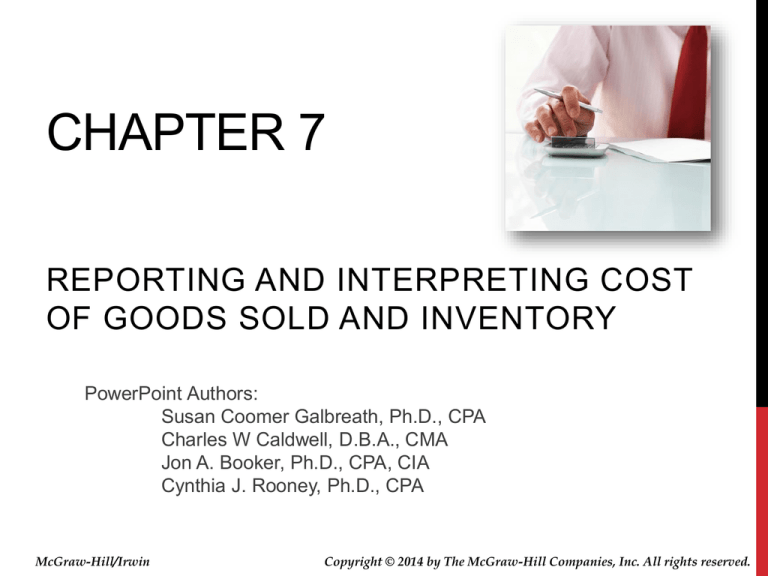
CHAPTER 7
REPORTING AND INTERPRETING COST
OF GOODS SOLD AND INVENTORY
PowerPoint Authors:
Susan Coomer Galbreath, Ph.D., CPA
Charles W Caldwell, D.B.A., CMA
Jon A. Booker, Ph.D., CPA, CIA
Cynthia J. Rooney, Ph.D., CPA
McGraw-Hill/Irwin
Copyright © 2014 by The McGraw-Hill Companies, Inc. All rights reserved.
UNDERSTANDING THE BUSINESS
Provide sufficient
quantities of highquality inventory.
Primary Goals of
Inventory
Management
Minimize the costs of
carrying inventory.
7-2
ITEMS INCLUDED IN INVENTORY
Merchandisers
Merchandise
Inventory
Manufacturing
Raw
Materials
Work in
Process
Finished
Goods
7-3
COSTS INCLUDED IN INVENTORY
PURCHASES
The cost principle requires that
inventory be recorded at the price paid
or the consideration given.
Invoice
Price
Freight-In
Inspection
Costs
Preparation
Costs
Any purchase returns and allowances and
purchase discounts taken are subtracted.
7-4
FLOW OF INVENTORY COSTS
7-5
COST OF GOODS SOLD EQUATION
Beginning
Inventory
Purchases
for the Period
Goods Available
for Sale
(Inventory
remaining)
(Inventory
sold)
Ending Inventory
Cost of Goods Sold
(Balance Sheet)
(Income Statement)
Beginning inventory + Purchases = Goods Available for Sale
Goods Available for Sale – Ending inventory = Cost of goods sold
7-6
PERPETUAL AND PERIODIC
INVENTORY SYSTEMS
Perpetual
Periodic
Purchase transactions
are recorded directly in
an inventory account.
No up-to-date record of
inventory is maintained
during the year.
Sales require two
entries to record: (1)
the retail sale and (2)
the cost of goods sold.
Sales require one
entry to record the
retail sale. Cost of
goods sold is
calculated.
7-7
INVENTORY COSTING METHODS
Inventory Costing Methods
1. Specific Identification
2. First-in, First-out (FIFO)
3. Last-in, First-out (LIFO)
4. Weighted Average
Total Dollar Amount of Goods
Available for Sale
Inventory Costing
Method
Ending Inventory
Cost of Goods Sold
7-8
SPECIFIC IDENTIFICATION
When units are
sold, the
specific cost of
the unit sold is
added to cost of
goods sold.
7-9
COST FLOW ASSUMPTIONS
The choice of an inventory
costing method is not based
on the physical flow of goods
on and off the shelves.
FIFO
LIFO
Weighted
Average
7-10
FIRST-IN, FIRST-OUT METHOD
Oldest Costs
Cost of
Goods Sold
Recent Costs
Ending
Inventory
7-11
LAST-IN, FIRST-OUT METHOD
Oldest Costs
Ending
Inventory
Recent Costs
Cost of
Goods Sold
7-12
AVERAGE COST METHOD
When a unit is sold, the
average cost of each unit in
inventory is assigned to
cost of goods sold.
Cost of Goods
Available for ÷
Sale
Number of
Units
Available for
Sale
7-13
PERPETUAL INVENTORY SYSTEMS AND
COST FLOW ASSUMPTIONS IN PRACTICE
FIFO inventory and cost of
goods sold are the same
whether computed on a
perpetual or periodic basis.
Accounting systems that keep
track of the costs of individual
items normally do so on a FIFO
or average cost basis.
As a consequence,
companies that wish to
report under LIFO
convert the outputs of
their perpetual inventory
system to LIFO with an
adjusting entry at the
end of each period.
7-14
FINANCIAL STATEMENT EFFECTS OF
INVENTORY COSTING METHODS
7-15
INTERNATIONAL PERSPECTIVE
LIFO AND INTERNATIONAL COMPARISONS
While U.S. GAAP allows companies to choose between FIFO,
LIFO, and weighted average inventory methods, International
Financial Reporting Standards (IFRS) currently prohibit the
use of LIFO.
GAAP allows different
inventory accounting
methods to be used for
different types of inventory
items.
IFRS requires that the
same method be used for
all inventory items that
have a similar nature and
use.
These differences can create comparability problems when
one attempts to compare companies across international
borders.
7-16
FINANCIAL STATEMENT EFFECTS OF
INVENTORY COSTING METHODS
Advantages of Methods
First-In,
First-Out
Last-In,
First-Out
Weighted
Average
Ending inventory
approximates
current
replacement cost.
Better matches
current costs in cost
of goods sold with
revenues.
Smoothes out
effects of price
changes.
7-17
MANAGERS CHOICE OF INVENTORY
METHODS
Net Income Effects
Managers prefer to report
higher earnings for their
companies.
Income Tax Effects
Managers prefer to pay the
least amount of taxes
allowed by law as late as
possible.
LIFO Conformity Rule
If last-in, first-out is used to compute
taxable income, it must also be used to
calculate inventory and cost of goods
sold for financial statements.
7-18
VALUATION AT LOWER OF COST OR
MARKET
Ending inventory is reported at the
lower of cost or market (LCM).
Replacement Cost
The current purchase
price for identical goods.
The company will recognize a “holding” loss in
the current period rather than the period in which
the item is sold.
This practice is conservative.
7-19
INTERNAL CONTROL OF INVENTORY
Separation of inventory
accounting and physical
handling of inventory.
Storage in a manner that
protects from theft and
damage.
Limiting access to
authorized employees.
Maintaining perpetual
inventory records.
Comparing perpetual
records to periodic
physical counts.
7-20
ERRORS IN MEASURING ENDING
INVENTORY
Errors in Measuring Inventory
Ending Inventory
Beginning Inventory
Overstated Understated Overstated Understated
Effect on Current Period's Balance Sheet
Ending Inventory
Retained Earnings
+
+
-
N/A
N/A
-
+
N/A
N/A
+
+
+
-
+
+
-
+
+
Effect on n Current Period's Income Statement
Goods Available for Sale
Cost of Goods Sold
Gross Profit
Net Income
7-21
INVENTORY AND CASH FLOWS
Add Decrease in Inventory
Increase in Accounts
Payable
Net Income
Cash Flows
from
Operations
Increase in Inventory
Decrease in Accounts
Subtract
Payable
7-22
END OF CHAPTER 7
7-23





